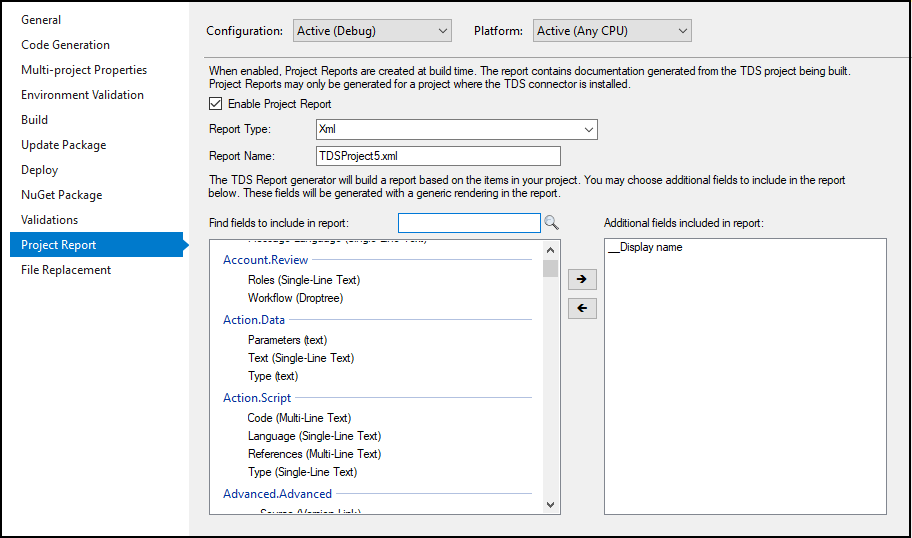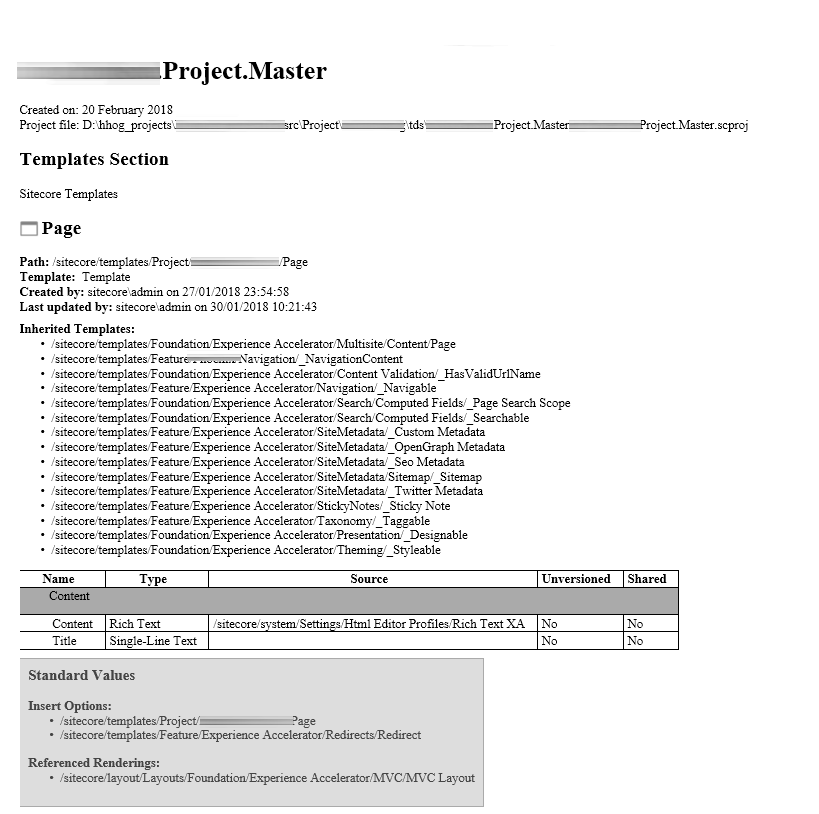Blog
March 27, 2018 | Una Verhoeven
As part of quality control, many companies are legally obligated to provide documents and additional resources for technical audits.
Often a requirement of a release to Production is that the implementation partner must provide extra release documentation, including the impact the change has and (possibly) other information. Most companies, for example, have their own standards in place; coding standards, quality checks or backup plans could also be part in the documentation. These are the components that developers must provide as a part of the change request. Incorporating the agile way of working, these are, generally, part of the agile definition of ‘done’.
When it comes to the specifications, these requirements are easily fulfilled. Each of the developers know what they have been working on and which files have been affected, but when it comes to the Sitecore items keeping track of these changes may be time consuming. Even though all changes are tracked in Source Control, it is not realistic to document every Sitecore item change - that would quickly become quite costly. A Sitecore developers time is better spent on the actual implementation rather than on the processes around it. Teams also frequently work on feature branches; once these are done, the feature branch gets deleted and merged to the Master branch. This makes the tracking even more time consuming.
This kind of functionality is available out of the box with Team Development for Sitecore. TDS Classic provides Project Report generation for Sitecore items.

To build a Project Report, you must have a valid TDS Classic connector with Sitecore’s site. TDS Classic will retrieve all the fields and templates for the selected project. Reports can be either in XML or Markdown (.md) format. The XML report will also create an XSLT to convert the XML into HTML, so it can be shown in a browser. If you wish to change the HTML displayed, you should edit the XSLT as needed. Once you run the build, the report will be generated on the file system where your TDS project is located, under the folder Report.

You can very easily filter the report since every item has Created by and Last updated by nodes.
Item report example:
Created by:sitecore\virtualssuser on 27/01/2018 23:55:00
Last updated by:sitecore\uverhoeven on 28/01/2018 00:09:05
With enabling Project Reporting, each of your teams will always have documented Sitecore change in a readable format in parallel with the Source Control version history.
Learn more about the helpful features of TDS Classic or start your free trial!
Tags
- TDS Classic goes to Australia
- Hedgehog Solution Architect, Sean Holmesby will be presenting at SUGCON ANZ. He gave insight on his topic and more.
- TDS Classic to Support Rainbow
- <p>At SUGCON London, Sitecore announced they would be switching over their default serialization format to Rainbow, a YAML-based format for Sitecore serialization in Sitecore version 9.2., and TDS Classic is ready to support it. </p> <div> </div>
- What is New in TDS Classic 5.8?
- We go over the new features in TDS Classic 5.8 that can help significantly improve your experience.
- Setting Up TDS 5.8 to Build to Azure Using Visual Studio Build and Pipelines: Configuring Azure DevOp's Release Pipeline
- In this part, we are configuring the setting in the Release pipeline to deploy our Web Deploy package.
- Setting Up TDS 5.8 to Build to Azure Using Visual Studio Build and Pipelines: Configuring Azure DevOp's Build Pipeline
- In this part, we'll configure only the steps in the Build Pipeline, and publish the build drop (a Web Deploy package and a PowerShell script) to the Release pipeline.
- Setting Up TDS 5.8 to Build to Azure Using Visual Studio Build and Pipelines: Local Set Up
- By using TDS 5.8 and Web Deploy packages, we'll show you how to create a fully automated build and deployment process from your workstation to source control and into your Azure environment.
- A Look Back at TDS Classic
- TDS Classic has been helping Sitecore developers for 10 years. We spoke with Sitecore Solution Architect and Chief Product Scientist, Charlie Turano to reflect back on the making TDS Classic.
- Hedgehog Announces the Release of TDS Classic 5.8
- Hedgehog announced the release of TDS Classic 5.8. The newest update now supports Azure and Visual Studio 2019.
- TDS Classic Licensing FAQ
- Answers to a number of frequently asked questions regarding the licensing of TDS Classic.
- The Benefits of Renewing a TDS Classic License
- New features and early access to the latest and greatest in the Essential Collection are just a few reasons to keep your TDS Classic license active.
- Guide to Sitecore Packaging
- Development of features and components requires a set of Sitecore items to be packaged - things like renderings and templates. With TDS Classic, Sitecore developers can automate the packaging process.
- TDS Classic: Content File Sync
- Content File Sync is a fantastic time saver for any Sitecore developer.
- TDS Classic How-To: Perform Unattended Installation of TDS Classic for Visual Studio 2017
- The TDS Classic version for Visual Studio 2017 is installed a bit differently than previous versions; the process is separated in two parts and performed by two different installers.
- Sitecore Security and Strengthening Your Sitecore Platform
- Improve the security of your Sitecore platform with these tips
- TDS Classic 5.7 - Lightning Deploy
- Lightning Deploy Mode can be used to enable Lightning Mode for all deployments that utilize the TDS Sitecore Connector in their configuration, improving their speed and efficiency.
- TDS Classic 5.7 - Lightning Sync
- Lightning Sync allows both sync and quick push operations to use TDS Classic 5.7's new Lightning Mode feature
- TDS Classic 5.7 - Solution Wide Sync
- A simple new feature in TDS Classic 5.7, Solution Wide Sync makes a big difference when working with many TDS Classic projects in a solution.
- TDS Classic 5.7 - Lightning Mode
- Lightning Mode helps to improve the speed and efficiency of both deploy and sync operations. This enhancement is achieved by modifying how item comparisons are performed.
- TDS Classic Best Practices: NuGet Build Components and TDS Classic .user configs
- There are certain systems and processes that you can put in place to make a TDS Classic project run more smoothly. We're highlighting the best practices that our team recommends for getting the most out of TDS Classic.
- TDS Classic Best Practices: Bundle Packages, Delta Builds and Delta Packages
- Following TDS Classic best practices, like using Delta Builds and Delta Packages, can make the entire development experience run much more smoothly.
- TDS Classic Best Practices: Validators and the Sitecore Package Deployer
- TDS Classic can be used in many ways, but the goal is always the same: make development (and developers lives) easier. Whether it's using the Sitecore Package Deployer or using validators, following best practices can make your entire experience run much more smoothly.
- Troubleshoot and Prevent Failed TDS Classic Project Builds
- When building an .update package with TDS Classic, the build might fail with no additional information. From increasing log verbosity to using validators, there are ways to minimize or prevent this type of error.
- TDS Classic How-To: Disable Automatic Code Generation
- Code Generation is automatically triggered after every change in the TDS Project tree. If a project contains many items, users can disable this feature for their convenience.
- TDS Classic Sitecore Deploy Folder
- Sitecore Deploy Folder is a setting, located in the build tab of the TDS Classic Project's Properties page, and used to tell TDS Classic where the webroot is located.<br>
- TDS Classic Builds on Jenkins Build Server with NuGet Packages
- Our simple scenario includes 2 developers using TDS Classic and checking-in changes to source control. The Jenkins build server takes the changes and performs the build, and then deploys the created package to two Sitecore environments.
- Features to Improve Sitecore Development: TDS Classic Strikes Back
- Each and every feature in TDS Classic is aimed at helping developers. Whether the feature is out front or running quietly in the background the goal is always the same: make the development experience better.
- TDS Classic Features to Improve Sitecore Development
- Each version of TDS Classic comes with the same goal: to make Sitecore development and, by extension, developers, lives easier. Every feature in our products is aimed at making the process better - some of these features aren't quite as well-known as others, but they all help smooth and improve the development experience.
- Deployment Properties and the Deployment Property Manager
- When working with TDS Classic, you will eventually need to deploy your items to a Sitecore instance and you might not want the default behavior of every item in your TDS project deploying every time. This is where the TDS Sitecore Deployment Property Manager comes in!
- TDS Classic How-To: Use the HedgehogDevelopment.TDS NuGet Package
- The HedgehogDevelopment.TDS NuGet Package allows you to build TDS projects, without the need of installed TDS on the build server machine.
- TDS Classic 5.6 Feature Spotlight - Prevent Deployment of Incorrect Assemblies
- This feature, new to TDS Classic 5.6, will prevent a solution from deploying unless all assemblies (except the excluded assemblies we allow you to specify) match what exists in your webroot.
- TDS 5.6 Feature Spotlight - Project Item Report
- This feature, new to TDS Classic 5.6, allows you to create a report of all items in the TDS Classic project.
- Create TDS Classic Custom Post Deploy Step
- Team Development for Sitecore Classic version 5.5 allows developers to add post deployment steps to to their deployments and update packages. TDS Classic has used post deployment steps internally to perform a number of useful functions. Many of the developers using TDS Classic have requested the ability to add their own post deploy functionality. With the release of TDS Classic 5.5 in early 2016, this functionality is now available.
